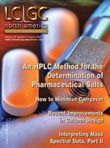Peaks of Interest
News from the chromatography industry.
Millipore completes acquisition of Serologicals
Millipore Corporation (Billerica, Massachusetts) announced that it has completed its acquisition of Serologicals following approval by Serologicals' shareholders last week. The acquisition will transform Millipore into a life science company with combined annual revenues of approximately $1.4 billion, based on 2006 full year projections.
The combined organization of approximately 5800 employees also will have significantly expanded R&D capabilities with more than 500 R&D professionals worldwide.
Neue and Molnar awarded at symposium
The 6th Balaton Symposium on High-Performance Separation Methods was held in Siofok, Hungry. The first Balaton Conference in 1955 was sponsored by the Chromatographic Group of the Hungarian Chemical Society. In the past ten years, the society has increased in size and international recognition. The symposium included more than 30 oral and nearly 140 poster presentations with more than 360 registered delegates from 23 countries.
During the symposium, several individuals were recognized for their accomplishments in the field of separation science. Director of External Research at Waters Corporation (Milford, Massachuetts) and LCGC author and reviewer Uwe D. Neue was presented with the 2005 Halasz Medal Award. Imre Molnar of the Molnar Research Institute (Berlin, Germay) and a previous member of the LCGC editorial board, was presented with the 2005 Csaba Horvath memorial Award.
Thermo launches on-line chromatography resource center
Thermo Electron Corporation (Waltham, Massachusetts) has developed a new web-based chromatography resource center to provide tools and technical advice to chromatographers. The chromatography resource center is readily accessible via http://www.thermo.com/columns.
Beckman Coulter adopts ARTEL technology
ARTEL announced that Beckman Coulter has adopted the ARTEL MVS (Multichannel Verification System) to verify the accuracy and precision of its automated liquid handling systems used in pharmaceutical and clinical laboratories. As part of Beckman Coulter's Field Service Operational Qualification Program, the MVS provides solid documentation about system performance, helping laboratories meet compliance and regulatory requirements.

A Novel LC–QTOF-MS DIA Method for Pesticide Quantification and Screening in Agricultural Waters
May 8th 2025Scientists from the University of Santiago de Compostela developed a liquid chromatography quadrupole time-of-flight mass spectrometry (LC–QTOF-MS) operated in data-independent acquisition (DIA) mode for pesticide quantification in agriculturally impacted waters.
Investigating 3D-Printable Stationary Phases in Liquid Chromatography
May 7th 20253D printing technology has potential in chromatography, but a major challenge is developing materials with both high porosity and robust mechanical properties. Recently, scientists compared the separation performances of eight different 3D printable stationary phases.

.png&w=3840&q=75)

.png&w=3840&q=75)



.png&w=3840&q=75)



.png&w=3840&q=75)









